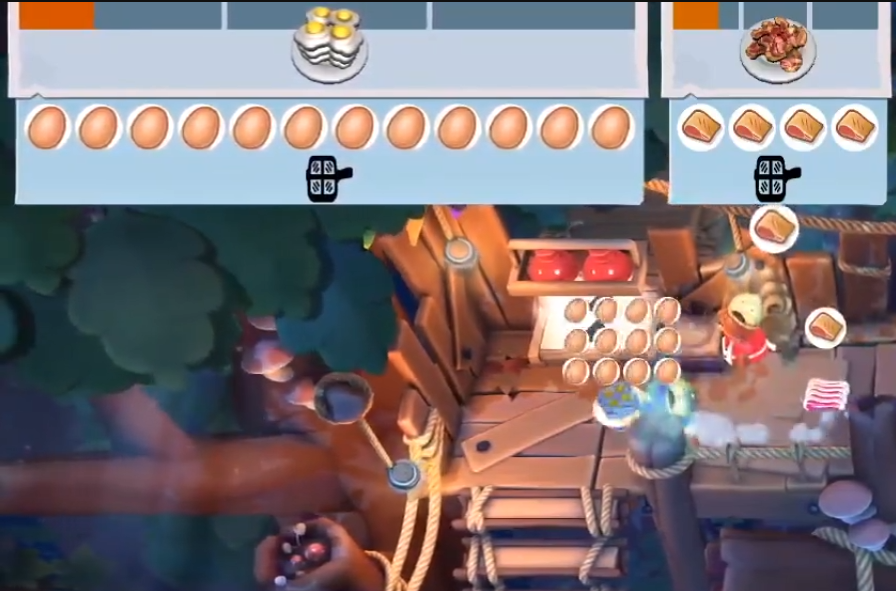Overcooked! 2 Modding
Welcome to my modding documentation!
Simple Modding

Simple mods require only C# code editing, and can be done easily with dnSpy, optionally BepInEx.
See for example my Leaderboard Mod on GitHub (the screenshot above).
Advanced Modding

More sophisticated mods also require adding new Unity assets.
See for example my Breakfast Mod (a gameplay video with Overtyr, greeny, and BunnyBrittany).
1 - Simple Modding
Modding that only requires editing C# code.
Disclaimer
Overcooked is a trademark of Team17. By no means is any content on this site intended to infrige on any rights of Team17. Please
contact me if you are concerned.
Basics of the Game Structure
Overcooked! 2 is written in Unity version 2017.4.8 with no IL2CPP compilation.
The game files contain these major parts that we care about:
Overcooked2.exe - the main executableOvercooked2_Data/StreamingAssets/Windows/ - all the Unity assets (models, textures, sounds, etc.)Overcooked2_Data/Managed/Assembly-CSharp.dll - all the C# code used by the assets
For simple modding, we only need to edit the Assembly-CSharp.dll.
Editing C# Code
First, we need to inspect and understand the C# code we care about. dnSpy is a great tool for this.
To edit the code, we can either
- Use dnSpy to directly edit the dll. This is the simplest method; or
- Use BepInEx to dynamically inject modified code at runtime. This requires a bit more setup, but is highly
recommended for more complex code editing, because it allows you to manage your code with version control,
and makes the code injection easily reproducible.
There is plenty of tutorial and documentation on how to use dnSpy and BepInEx, so I won’t go into details here.
How do I …?
The Overcooked codebase is fairly complex, so it’s not always easy to find where certain game logic is. A fair amount of investigation is needed in general to make complex mods.
Refer to the Overcooked! 2 Tech Docs for some documentation about the trickest parts of the game code.
The rest is up to your imagination and determination. Good luck!
2 - Advanced Modding
Beyond editing C# code, you can also add new Unity assets.
Disclaimer
Overcooked is a trademark of Team17. By no means is any content on this site intended to infrige on any rights of Team17. Please
contact me if you are concerned.
Limitations of C# Editing
There is a lot you can do with just editing C#, but there are also strong limitations:
- It’s impossible to add new 3D models.
- It’s hard or impossible to add new 2D content.
- It’s very difficult to modify parameters that are encoded in Unity assets rather than in the code.
- For example, the list of recipes that are available for a level is not encoded in
Assembly-CSharp.dll,
but in assets that are specific to the level. It’s possible to change this in the code, but it’s very
awkward and requires creative trickery.
Difficulty of Unity Asset Editing
You may have heard of tools like AssetStudio or UABE that can extract and edit Unity assets. Unfortunately,
none of these work well for this game. There are a few reasons:
- These tools mostly specialize in replacing graphical or audio assets, but most Overcooked mods would
also require editing
ScriptableObject objects (essentially, simple serialized objects without graphics).
That makes these tools rather awkward to use. - The game uses streaming assets, which are newer than the old Unity asset formats supported by these outdated
tools. I wasn’t able to get any of these to work even for basic asset replacement.
Using Unity Itself to Add Assets
The fact that the game uses StreamingAssets is actually very helpful to us. It means that we can compile an
asset bundle using the official Unity Editor,
and then just load it at runtime.
This is so clean - we don’t need to modify any of the existing assets at all. If we need to replace an
existing asset, we can always just edit the code to modify some variable to point to our new asset.
However, there is a serious challenge. It’s not very useful to just add fresh new assets. These assets
need references to existing assets. This becomes a real problem when creating these assets in Unity,
since we don’t have the existing assets to reference at all.
It would be nice if we could load existing assets into the Unity Editor, but that’s not how it works.
The Unity compilation process is lossy so that it’s not possible to revert the compiled assets back to
editable assets.
A Creative Solution
We’ll first use uTinyRipper to reverse-engineer the game into
a Unity project. This is far from perfect - there are numerous problems with the generated project, but
it will give us the existing assets just so that they can be referenced. If we create a new asset
this way and compile it into a new asset bundle (without the existing assets), when loading it at
runtime, the new asset will reference the real existing asset in the game (because they have the same
object ID as the reverse-engineered assets).
This is the basic idea, but there are a few more major issues to work out:
- The generated project is not compilable, and Unity will refuse to export asset bundles unless we make
it compilable.
- uTinyRipper cannot decompile shaders, so any new asset we create has defective materials that must
be fixed at runtime.
- We cannot easily add new C#-backed components that are referenced by new assets, because there is a
circular dependency problem.
Note
TODO: More details about these issues.Discord
Use this link to join my Overcooked Modding and TAS Discord Server!

